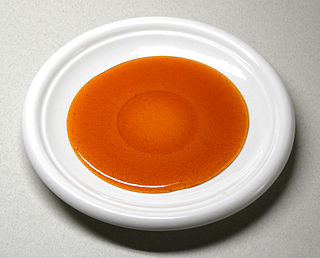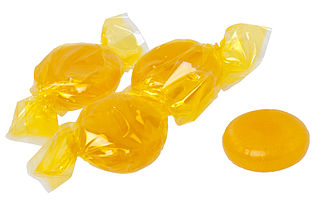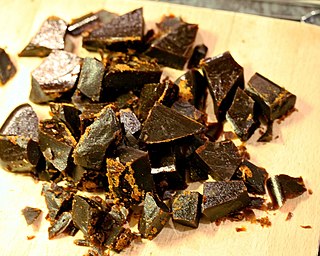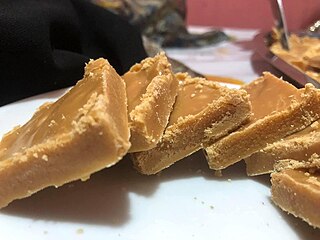
Confectionery is the art of making confections, or sweet foods. Confections are items that are rich in sugar and carbohydrates although exact definitions are difficult. In general, however, confections are divided into two broad and somewhat overlapping categories: bakers' confections and sugar confections.

Caramel is a confectionery product made by heating a range of sugars. It is used as a flavoring in puddings and desserts, as a filling in bonbons or candy bars, or as a topping for ice cream and custard.

Pralines are confections containing nuts – usually almonds, pecans and hazelnuts – and sugar. Cream is a common third ingredient.

Condensed milk is cow's milk from which water has been removed. It is most often found with sugar added, in the form of sweetened condensed milk, to the extent that the terms "condensed milk" and "sweetened condensed milk" are often used interchangeably today. Sweetened condensed milk is a very thick, sweet product, which when canned can last for years without refrigeration if not opened. The product is used in numerous dessert dishes in many countries.

Shortbread or shortie is a traditional Scottish biscuit usually made from one part white sugar, two parts butter and three to four parts plain wheat flour. Shortbread does not contain any leavening, such as baking powder or baking soda. Shortbread is widely associated with Christmas and Hogmanay festivities in Scotland, and some Scottish brands are exported around the world.

Fudge is a type of dessert bar that is made by mixing sugar, butter and milk. It has its origins in the 17th century United States, and became popular in American women's colleges in the late 19th century. Fudge can come in a variety of flavorings depending on the region or country it was made; popular flavors include fruit, nut, chocolate and caramel. Fudge is often bought as a gift from a gift shop in tourist areas and attractions.

Butterscotch is a type of confection whose primary ingredients are brown sugar and butter. Some recipes include corn syrup, cream, vanilla, and salt. The earliest known recipes, in mid-19th century Yorkshire, used treacle (molasses) in place of, or in addition to, sugar.

Rice pudding is a dish made from rice mixed with water or milk and commonly other ingredients such as sweeteners, spices, flavourings and sometimes eggs.
Penuche is a fudge-like candy made from brown sugar, butter, and milk, using no flavorings except for vanilla. Penuche often has a tannish color, and is lighter than regular fudge. It is formed by the caramelization of brown sugar; thus, its flavor is said to be reminiscent of caramel. Nuts, especially pecans, are often added to penuche for texture, frequently in the making of penuche candies. It is primarily a regional food, found in New England and some places in the Southern United States, though in the latter it goes by different names, including creamy praline fudge, and brown sugar fudge candy.

Stovies is a Scottish dish based on potatoes. Recipes and ingredients vary widely but the dish contains potatoes, fat, usually onions and often pieces of meat. In some versions, other vegetables may be added.

Banoffee pie is a British dessert pie made from bananas, whipped cream, and a thick caramel sauce, combined either on a buttery biscuit base or one made from crumbled biscuits and butter. Some versions of the recipe include chocolate, coffee, or both.

Bonfire toffee is a hard, brittle toffee associated with Halloween and Guy Fawkes Night in the United Kingdom. The toffee tastes very strongly of black treacle (molasses), and cheap versions can be quite bitter. In Scotland, the treat is known as claggum, with less sweet versions known as clack. In Wales, it is known as loshin du.

Scottish cuisine encompasses the cooking styles, traditions and recipes associated with Scotland. It has distinctive attributes and recipes of its own, but also shares much with other British and wider European cuisine as a result of local, regional, and continental influences — both ancient and modern.

A tattie scone or potato scone is a regional variant of the savoury griddle scone which is especially popular in Scotland. Many variations of the recipe exist. They generally include liberal quantities of boiled potatoes, butter and salt.

Clapshot is a traditional Scottish dish that originated in Orkney and may be served with haggis, oatcakes, mince, sausages or cold meat. It is created by the combined mashing of swede turnips and potatoes with the addition of chives, butter or dripping, salt and pepper; some versions include onions. The name is Orcadian in origin.

Kalakand is a sweet cheese confection from India. It has been described as "akin to Italian cheesecake, firmer in texture than milk cake, but softer than burfis."

Krówki, literally meaning "little cows," are Polish fudge, semi-soft milk toffee candies. When hand-made, they are hard and crispy on the outside, but the inside is more fluid than solid.
Hatted kit, or hattit kit, is a traditional Scottish milk dish. The fresh milk used in the recipe must be warm and traditionally it was made by milking straight from a cow into a pail or other vessel containing fresh buttermilk and sometimes rennet. Recipes variously instruct to mix well or to refrain from stirring. More milk was added at the next milking. The resultant "hat" that floats atop the whey is then skimmed off and mixed with sugar, nutmeg or cinnamon and sometimes wine. The hatted kit tends to become more acid, so limewater or charcoal may be added with later use of a batch. It may be served with cream, stewed fruit or with brown bread and salt, instead of butter.

Kiri Aluwa, also known as milk toffee or kiri toffee, is a popular traditional Sri Lankan soft toffee.

















